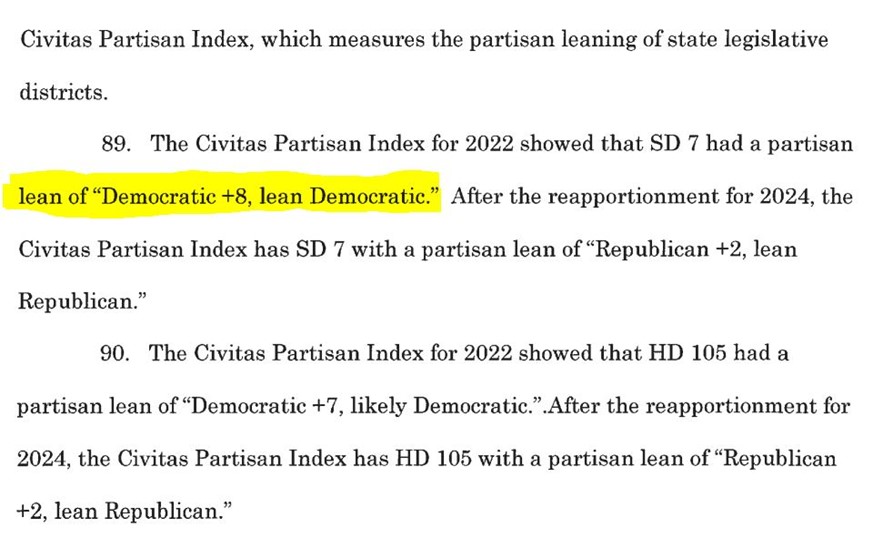Recently, retired North Carolina Supreme Court justice and 2022 redistricting special master Bob Orr filed a lawsuit challenging the redrawn congressional and state legislative maps based on “fairness.” My colleague Dr. Andy Jackson explained how the plaintiff’s central claim in this lawsuit is just another partisan gerrymandering claim presented under a new name. The case will likely rehash the familiar arguments the court heard in the recent partisan gerrymandering case, Harper v. Hall.
One difference between this case and Harper, however, has to do with the evidence presented to the court by the plaintiffs. Instead of hiring their own redistricting experts to analyze districts, plaintiffs used the Civitas Partisan Index (CPI) as evidence against the new Senate District 7 (SD 7) and House District 105 (HD 105). The CPI is a tool published by the John Locke Foundation to evaluate the partisan lean of North Carolina General Assembly districts. While the CPI was accurate in over 94 percent of races in 2020 and 2022, the plaintiffs misused the CPI in three ways.
Incorrect Rating of Senate District 7
The most obvious error is misreporting the CPI’s 2022 rating for SD 7. As part of the lawsuit’s factual allegations, the plaintiffs claim the 2022 CPI rating of the district was a D+8, which would make it a lean Democratic seat. In reality, SD 7 was rated a D+0 in the 2022 CPI and was considered a toss-up seat.

Not only do the plaintiffs’ claims misstate the district’s rating, but they also misrepresent the CPI’s scale for rating districts. A D+8 district would be considered a likely Democratic seat, not a lean Democratic seat.
Current House District 105 Has Little Overlap with Its Prior Namesake
Although the plaintiffs do accurately state both the 2022 and 2024 CPI ratings for HD 105, it is misleading to compare the 2022 and 2024 ratings for the districts that share this name. 2024’s version of HD 105 shares only two precincts with its prior iteration. These precincts equate to roughly 11.3 percent of the district’s population.
The current HD 105 pulls most of its population from the 2022 version of HD 103, which the CPI D+2 that year. Comparing these districts simply because they share the same name leads to an inaccurate depiction of the effect that redistricting had on a district. Suppose a district was left unmodified between maps, apart from receiving a change to its name. You would not then compare it to a prior district that shared that name.
For example, if House District 1 in 2022 were renamed House District 32 in 2024, you would not compare 2022’s House District 32 to the 2024 version of House District 32. You would use the data for the previous House District 1 and compare it to the current House District 32. What is important is a district’s geography, not its name.
Failing to Account for the Year-to-Year Changes in the CPI
Aside from the specific issues with the House and Senate districts cited in the lawsuit, the plaintiffs fail to account for how we at the John Locke Foundation calculate the CPI. The CPI describes the partisan leaning of a district as compared to the average partisan leaning of the state. Consequently, it is not a static scale from year to year.
The CPI is adjusted after every election. In the 2024 iteration, we update the CPI by including the most recent statewide judicial elections. Due to this, the CPI has three variables modified from its 2022 iteration:
- The average partisan leaning of the state, changing from 50.76% to 51.36% favoring Republicans,
- The total number of votes from all elections used in the CPI,
- and the geographic changes in the districts due to redrawing the maps.
Plaintiffs do not account for the first two variables, focusing solely on the geographic changes from legislators redrawing districts. Because there are multiple variables that change with the CPI from year to year, the way plaintiffs utilize the CPI creates an apples-to-oranges comparison.
For example, in both iterations of the legislative house maps, House District 22 consisted of Sampson and Bladen County in their entirety. The district was rated an R+7 in 2022 but changed to an R+8 in 2024.
(Plaintiffs utilize the 2020 Presidential election when comparing the two congressional maps. Because this utilizes the same data, the only variable changing between the maps is the districts themselves.)
The plaintiffs’ failure to include these facts paints an inaccurate picture of how much a district has been altered due to the redrawing of districts. While the CPI is an excellent tool for understanding a district’s political standing, trying to utilize it for an apples-to-apples comparison of the districts from year to year doesn’t work. There are more variables in play than simply the shift in district lines.
